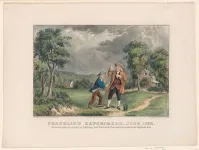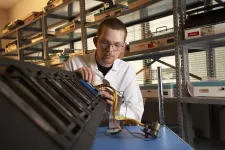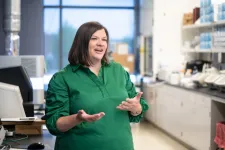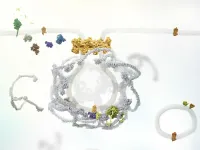(Press-News.org) Illustrations of scientific experiments play a fundamental role in both science education and the dissemination of scientific knowledge to the general public. Confirming the adage that “a picture is worth a thousand words,” these depictions of famous experiments remain in the minds of those who study them and become definitive versions of the scientific process. Archimedes in the bath discovering the law of buoyancy; Newton refracting sunlight with a prism and defining the principles of modern optics; Mendel cultivating peas and laying the foundations of genetics – these are just a few well-known examples.
Many of these depictions convey false information, either because the experiments never actually happened or because they were performed quite differently. People who try to reproduce them on the basis of what the illustrations depict might not get any results at all or could even face dangerous consequences.
A study supported by FAPESP and conducted by Breno Arsioli Moura, a researcher at the Federal University of the ABC (UFABC) in São Paulo state, Brazil, investigated depictions of one of these famous experiments, in which Benjamin Franklin (1706-1790) flew a kite to draw electricity from a thundercloud.
An article on the study is published in the journal Science & Education.
Franklin was one of the leaders of the American Revolution and the first United States Ambassador to France. He was a Deist, a Freemason, and one of the most renowned personifications of the Enlightenment in the eighteenth century. His many interests included religion, philosophy, politics, and moral and social reform, and he was one of the foremost inventors and scientists of his time. “The kite experiment is Franklin’s most famous scientific achievement. In the article I analyze seven illustrations of the event published later on, in the nineteenth century,” Moura told Agência FAPESP.
In fact, he added, the kite experiment was designed to be a simpler version of another experiment Franklin thought up in 1750 and which is now known as the “sentry box” experiment. “A kind of sentry box was to be set up on top of a tower, steeple or hill, and a man would stand inside it on an insulating dais made of wax, with a long, sharply pointed iron rod measuring some 10 meters inserted into it [see the first figure in the gallery at the bottom of this page]. Franklin expected the tip of the rod to ‘draw fire’ from the clouds. If the experimenter brought his knuckles close to the bottom of the rod, he would produce sparks,” Moura said. “It’s important to note two things. The experiment wasn’t to be performed during a storm to take advantage of lightning strikes, and the rod wasn’t to be earthed but anchored by the insulating stand so that all the electricity extracted would be stored in it.”
Franklin’s proposal stayed on paper until a highly similar experiment was performed by French researchers in 1752. Its success drew even more international attention to his work on electricity. “When he heard about the French experiment, Franklin wrote to a correspondent in England that a simpler version of the experiment had been performed in Philadelphia, where he lived. This was in fact the kite experiment,” Moura said.
The kite consisted of a “small cross made of two light strips of cedar, the arms so long as to reach to the four corners of a large thin silk handkerchief when extended”, Franklin wrote. A “very sharp-pointed wire” was tied to the “top of the upper stick of the cross, rising a foot or more above the wood”. The principle was the same as in the sentry box proposal. A key was fastened to the end of a silk ribbon, which in turn was tied to the end of the string (silk is an insulator).
“The experimenter held the apparatus by the silk ribbon so that electricity drawn down ‘silently’ from the clouds by the kite and conveyed along the string was stored in the key. As in the sentry box experiment, the kite was insulated, not earthed. By approaching a finger or knuckle, the experimenter could draw sparks,” Moura explained.
Like other eighteenth-century natural philosophers, Franklin thought of electricity as a fluid built up and then discharged, flowing from one place to another. This fluid could be obtained in the laboratory by rubbing a glass tube with a piece of leather and stored in a Leyden jar, invented in mid-century by Dutch scientists. The general idea behind the sentry box and kite experiments was to show that the fluid could also be drawn from the clouds. Franklin was fascinated by the physics of cloud electrification and other aspects of meteorology.
For example, he thought seawater was full of electric fluid, and that when it evaporated to form storms high above the ocean, it took this fluid with it, so that the clouds were full of electricity.
“In Franklin’s writings, there are no details showing whether he or someone else performed the experiment, but it does appear to have taken place. Another account of the experiment was produced 15 years later, in 1767, in a book by Joseph Priestley entitled The History and Present State of Electricity. Franklin helped Priestley obtain materials for the book and is therefore assumed to have agreed with its contents. Priestley’s account is far more detailed and includes participation in the experiment by Franklin’s son. However, it differs from the original 1752 account on several points,” Moura said.
In his study of the illustrations depicting Franklin’s kite experiment, Moura argues that they were based on Priestley’s account. Many show Franklin with his son as a small boy even though at the time he was actually 21. Some also contain more important errors. “Many show the experiment being performed in the open air even though Franklin specified that the experimenter must be in a ‘door or window, or under some cover, so that the silk ribbon may not be wet’, which would make it conductive. In most cases, the kite is being struck by lightning, or lightning bolts are very near it, although Franklin did not want to draw a lightning strike down upon himself. Most illustrations don’t show the silk ribbon that was meant to insulate the kite. Franklin simply holds the string. If that had been the case, he would have earthed the kite and ruined the experiment. One illustration shows Franklin holding the key near or on the string, which isn’t warranted by any account,” Moura said.
The illustrations should not be used indiscriminately, especially in science classes, he argued. They embody messages that can be construed in a confusing or wrong manner, both historically and scientifically, if they are not treated critically. As noted at the outset, the images stay in the mind of the viewer and any errors they foster are hard to eradicate.
END
Study points out errors in illustrations of one of the most famous scientific experiments
Described by Benjamin Franklin in the mid-eighteenth century, the kite experiment was an important step toward our modern understanding of electricity, but the pictures that popularized this episode are full of inaccuracies
2023-05-22
ELSE PRESS RELEASES FROM THIS DATE:
For urban children with asthma, where they live is strongest predictor of exacerbations
2023-05-22
ATS 2023, Washington, DC – For children with asthma residing in urban areas, the neighborhood they live in is a stronger predictor of whether they will have exacerbations (asthma attacks) than their family’s income or their parents’ level of educational attainment, according to research published at the ATS 2023 International Conference.
“Research has shown that social determinants of health underlie significant health disparities among children with asthma,” said the study’s corresponding author Emily Skeen, MD, pediatric pulmonary fellow, University of Colorado at Children’s Hospital Colorado, Aurora. ...
Public aware of and accept use of bacteria-killing viruses as alternative to antibiotics, study shows
2023-05-22
The public are in favour of the development of bacteria-killing viruses as an alternative to antibiotics – and more efforts to educate will make them significantly more likely to use the treatment, a new study shows.
The antimicrobial resistance (AMR) crisis means previously treatable infections can kill. This has revitalised the development of antibiotic alternatives, such as phage therapy, which was first explored over a century ago but abandoned in many countries in favour of antibiotics.
The study shows public acceptance of phage therapy is already ...
How a drought affects trees depends on what’s been holding them back
2023-05-22
(Santa Barbara, Calif.) — Droughts can be good for trees. Certain trees, that is.
Contrary to expectation, sometimes a record-breaking drought can increase tree growth. Why and where this happens is the subject of a new paper in Global Change Biology.
A team of scientists led by Joan Dudney at UC Santa Barbara examined the drought response of endangered whitebark pine over the past century. They found that in cold, harsh environments — often at high altitudes and latitudes — drought ...
RIT and URMC researchers study maternal nutrition and oral health for clues to childhood tooth decay
2023-05-22
Researchers from Rochester Institute of Technology and the University of Rochester Medical Center are taking a closer look at nutritional factors during pregnancy and in infancy associated with severe tooth decay in young children.
Brenda Abu, assistant professor in RIT’s Wegmans School of Health and Nutrition and a researcher in maternal and child health, is collaborating on a study to investigate the Oral Microbiome in Early Infancy (OMEI) and Nutrition. Perinatal oral health expert Dr. Jin Xiao, associate professor at the Eastman Institute for Oral Health, is leading a large project funded by the National ...
Two small businesses added to Sandia National Laboratories’ Mentor-Protégé program
2023-05-22
ALBUQUERQUE, N.M. — Sandia National Laboratories grew its Mentor-Protégé program from three companies to five with the addition of Dynamic Structures and Materials, LLC of Franklin, Tennessee, and Compunetics Inc., of Monroeville, Pennsylvania. The program not only helps small businesses develop and grow, but also helps foster long-term relationships that help Sandia achieve its mission.
As one of 17 DOE national laboratories, Sandia’s mission includes: anticipating and resolving emerging national security challenges and innovating and ...
Scientists at Wake Forest University School of Medicine discover metabolic sensor may play role in Alzheimer’s disease
2023-05-22
WINSTON-SALEM, N.C. – May 22, 2023 – It’s well-known that people with Type 2 diabetes are at an increased risk of developing Alzheimer’s disease, but the reason why isn’t fully understood and is an area of current research.
Now, scientists at Wake Forest University School of Medicine have uncovered a novel mechanism that shows increased sugar intake and elevations in blood glucose are sufficient to cause amyloid plaque buildup in the brain, which increases the risk of Alzheimer’s disease. Amyloid plaque is made up of toxic proteins in the brain.
The study findings appear online ...
Early Frontier users seize exascale advantage, grapple with grand scientific challenges
2023-05-22
With the world’s first exascale supercomputing system now open to full user operations, research teams are harnessing Frontier’s power and speed to tackle some of the most challenging problems in modern science.
The HPE Cray EX system at the Department of Energy’s Oak Ridge National Laboratory debuted in May 2022 as the fastest computer on the planet and first machine to break the exascale barrier at 1.1 exaflops, or 1.1 quintillion calculations per second. That’s more calculations per second than every human on Earth could perform in four years.
Frontier ...
Researchers modify drug to enter cells and treat pain
2023-05-22
Altering the chemical properties of an anti-nausea drug enables it to enter an interior compartment of the cell and provide long-lasting pain relief, according to a new study led by researchers at NYU College of Dentistry’s Pain Research Center.
The study, published in the Proceedings of the National Academy of Sciences (PNAS), illustrates how pain signaling occurs inside cells rather than at the surface, highlighting the need for drugs that can reach receptors within cells.
G protein-coupled receptors (GPCRs) are a large ...
Ozone treaty is delaying first ice-free Arctic summer
2023-05-22
A 1987 global deal to protect the ozone layer is delaying the first ice-free Arctic summer by up to 15 years, new research shows.
The Montreal Protocol – the first treaty to be ratified by every United Nations country – regulates nearly 100 man-made chemicals called ozone-depleting substances (ODSs).
While the main aim was to preserve the ozone layer, ODSs are also potent greenhouse gases, so the deal has slowed global warming.
The new study shows the effects of this include delaying the first ice-free ...
Montreal protocol is delaying first ice-free Arctic summer
2023-05-22
New York, NY—May 22, 2023—When scientists discovered a hole over Antarctica in 1985, countries across the globe got together and wrote a treaty designed to protect the ozone layer, which shields the Earth--and us--from harmful levels of ultraviolet radiation. The resulting Montreal Protocol, the only United Nations treaty ratified by every country in the world, was signed in 1987 and entered into effect in 1989, when little was known about its impact on the global climate. Its purpose was to reduce atmospheric concentrations of ozone-depleting substances (ODSs), materials ...
LAST 30 PRESS RELEASES:
HKU Engineering scholar demonstrates the smallest all-printed infrared photodetectors to date
Precision empowerment for brain "eavesdropping": CAS team develops triple-electrode integrated functional electrode for simultaneous monitoring of neural signals and chemical transmitters during sleep
Single-capillary endothelial dysfunction resolved by optoacoustic mesoscopy
HKU three research projects named among ‘Top 10 Innovation & Technology News in Hong Kong 2025’ showcasing excellence in research and technology transfer
NLRSeek: A reannotation-based pipeline for mining missing NLR genes in sequenced genomes
A strand and whole genome duplication–aware collinear gene identification tool
Light storage in light cages: A revolutionary approach to on-chip quantum memories
Point spread function decoupling in computational fluorescence microscopy
BacPhase: Long-insert paired-end sequencing for bin marker construction and genome phasing
GmWOX1 regulates the mediolateral polarity of compound leaves in soybean
ChargeFabrica: An open-source simulation tool that aims to accelerate search for high performance perovskite solar cells
High levels of ADAR overexpression induce abundant and stochastic off-target RNA editing in rice protoplasts
On-demand upgraded recycling of polyethylene and construction of sustainable multifunctional materials based on the "LEGO" strategy
New "Stomata in-sight" system allows scientists to watch plants breathe in real-time
Anorexia nervosa may result in long-term skeletal muscle impairment
Narrative-based performance reviews deemed fairest by employees
New insights reveal how advanced oxidation can tackle emerging water pollutants
New review shows how biomass can deliver low-carbon gaseous fuels at scale
Climate change is quietly rewriting the world’s nitrogen cycle, with high stakes for food and the environment
Study finds SGLT-2 inhibitors linked to lower risk of diabetic foot nerve damage
Microbes may hold the key to brain evolution
Study examines how the last two respiratory pandemics rapidly spread through cities
Gender stereotypes reflect the division of labor between women and men across nations
Orthopedics can play critical role in identifying intimate partner violence
Worms as particle sweepers
Second spider-parasitic mite described in Brazil
January 2026 issues of APA journals feature new research on autism, pediatric anxiety, psychedelic therapy, suicide prevention and more
Private equity acquired more than 500 autism centers over the past decade, new study shows
New cervical cancer screening guidelines from the US Department of Health and Human Services
Estimated burden of COVID-19 illnesses, medical visits, hospitalizations, and deaths in the US from October 2022 to September 2024
[Press-News.org] Study points out errors in illustrations of one of the most famous scientific experimentsDescribed by Benjamin Franklin in the mid-eighteenth century, the kite experiment was an important step toward our modern understanding of electricity, but the pictures that popularized this episode are full of inaccuracies







